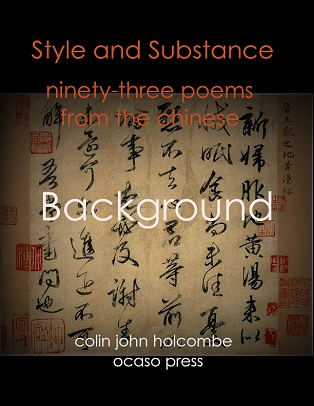As a background to the author's translation
of 93 poems from all
periods,
genres and styles, this 61,000 word survey places the poetry of
imperial
China in its cultural and linguistic setting. Included are extended
chapters
on China's history and language, the anatomy of Chinese poems, their
themes, expectations and styles.
The history of translation is surveyed in some detail, with a close
examination of the translation issues
that arise. New models to distinguish genres and styles are needed,
and the survey ends with specific recommendations. All chapters are
fully referenced to the most helpful
of online literature.
My underlying contention is that today’s preferred model, the so-called
‘Modernist free verse’ model, has outlived its usefulness, and we
must now go back to fundamentals.

Academic renderings, it goes without saying, must aim for semantic accuracy, even if that fidelity generally leaves the poetry a distant second. Translations by modern poets, however, do of course add some aesthetic and rhythmic shaping, but these reworkings are still in my view far from sufficient to capture the exceptional refinement, musicality and intricately rule-based nature of Chinese verse.
As a
consequence, neither group captures the genres, periods and individual
voices properly, tending to make all renderings sound very much the
same.
I suggest the models needed lie somewhere between true free verse and
traditional verse, perhaps close to early Modernist experiments. Far
from being written in an antiquated style, as it may doubtless seem,
the translations presented in Volume One are in fact responding to two
key developments. First is a better appreciation of the nature and
structure of Chinese poems through the publication of detailed studies
aimed at the general reader, which disclose features not captured by
our current renderings. The second development is the increasingly
prose-like nature of contemporary poetry, which is too plebian to
represent the refined and somewhat artificial nature of Chinese poetry.
A free pdf ebook.
Preface
Introduction
1. China: Historical and Cultural Overview
2. Chinese Language
2.1 In Outline
2.2 In Practice
3. Anatomy of Chinese Poems
3.1 Form and Spirit
3.2 Nuts and Bolts
3.3 Shijing
3.4 Regulated Shi
3.5 Ci Poetry
4. Chinese Poetry Themes
5. Previous Translations
5.1 Brief History
5.2 Modernist Models
5.3 Contemporary Precepts
6. Verse, Free Verse and Prose
6.1 Introduction
6.2 Free Verse and Prose Verse
6.3 Progression of Prose into Verse
7. Translation Issues
7.1 Genres
7.2 Fidelity
7.3 Improvisation.
7.4 Style
7.5 Allusion
7.6 Rhyme and No Rhyme
7.7 Tones
7.8 Parallelism
7.9 Longer Lines
8. Models Devised Here
8.1 Genres: Shi and Ci Distinctions
8.2. Shijing
8.3 Sao
8.4 Fu
8.5 Pre-Tang Experiments
8.6 Unregulated Shi
8.7 Regulated Shi
8.8 Qu
8.9 Ci Poetry
9. Individual Voices
10. Conclusions and Recommendations
10.1 Points to Bear in Mind
10.2. Suggested Principles
10.3 Avoiding Banality
10.4 Greeting Card Verse
10.5 Writing Decent Verse
10.6 Common Sense
10.7 Respecting the Social and Cultural Setting
10.8 Emotive Content
10.9 Recommendations